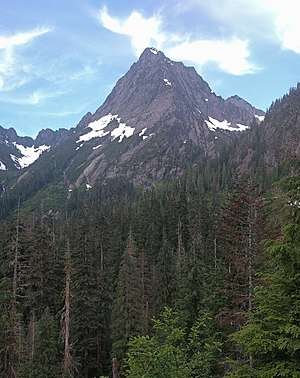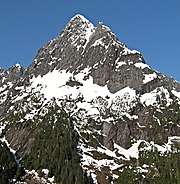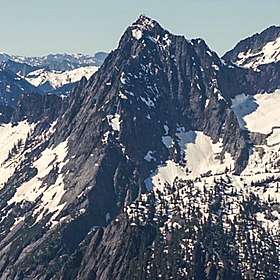Sperry Peak
Sperry Peak is a 6,120+ ft (1,870+ m) mountain summit located in the South Fork Stillaguamish River Valley near the western edge of the North Cascades, in Snohomish County of Washington state.[3] It is located 2.5 miles (4.0 km) east of Barlow Pass near the Mountain Loop Highway and the Monte Cristo area, on land managed by the Mount Baker-Snoqualmie National Forest. Its nearest higher peak is Vesper Peak, 0.74 miles (1.19 km) to the west, and between them share a high connecting ridge. The peak was named for A. D. (Dick) Sperry, a Silverton mining prospector during the 1890s.[2] The Dick Sperry Picnic Area is near the historic site of the abandoned Sperry-Iverson mine near Silverton.
| Sperry Peak | |
|---|---|
 Sperry Peak | |
| Highest point | |
| Elevation | 6,120 ft (1,870 m) [1] |
| Prominence | 720 ft (220 m) [1] |
| Coordinates | 48°00′57″N 121°30′09″W [1] |
| Geography | |
 Sperry Peak  Sperry Peak Sperry Peak (the United States) | |
| Parent range | North Cascades Cascade Range |
| Topo map | USGS Silverton |
| Geology | |
| Age of rock | 260 to 370 million years |
| Type of rock | metamorphosed sandstone shale, conglomerate[2] |
| Climbing | |
| First ascent | 1927 by Norval Grigg and Art Winder[2] |
| Easiest route | Scrambling Southwest slope |
Climate

Sperry Peak is located in the marine west coast climate zone of western North America.[2] Most weather fronts originate in the Pacific Ocean, and travel northeast toward the Cascade Mountains. As fronts approach the North Cascades, they are forced upward by the peaks of the Cascade Range, causing them to drop their moisture in the form of rain or snowfall onto the Cascades (Orographic lift). As a result, the west side of the North Cascades experiences high precipitation, especially during the winter months in the form of snowfall.[2] Due to its temperate climate and proximity to the Pacific Ocean, areas west of the Cascade Crest very rarely experience temperatures below 0 °F (−18 °C) or above 80 °F (27 °C).[2] During winter months, weather is usually cloudy, but, due to high pressure systems over the Pacific Ocean that intensify during summer months, there is often little or no cloud cover during the summer.[2] Because of maritime influence, snow tends to be wet and heavy, resulting in high avalanche danger.[2]
Geology
The North Cascades features some of the most rugged topography in the Cascade Range with craggy peaks, ridges, and deep glacial valleys. Geological events occurring many years ago created the diverse topography and drastic elevation changes over the Cascade Range leading to various climate differences.

The history of the formation of the Cascade Mountains dates back millions of years ago to the late Eocene Epoch.[4] With the North American Plate overriding the Pacific Plate, episodes of volcanic igneous activity persisted.[4] In addition, small fragments of the oceanic and continental lithosphere called terranes created the North Cascades about 50 million years ago.[4]
During the Pleistocene period dating back over two million years ago, glaciation advancing and retreating repeatedly scoured the landscape leaving deposits of rock debris.[4] The “U”-shaped cross-section of the river valleys are a result of recent glaciation. Uplift and faulting in combination with glaciation have been the dominant processes which have created the tall peaks and deep valleys of the North Cascades area.
References
- "Sperry Peak, Washington". Peakbagger.com.
- Beckey, Fred W. Cascade Alpine Guide, Climbing and High Routes. Seattle, WA: Mountaineers Books, 2008.
- "Sperry Peak". Geographic Names Information System. United States Geological Survey. Retrieved 2019-08-14.
- Kruckeberg, Arthur (1991). The Natural History of Puget Sound Country. University of Washington Press.
External links
- Sperry Peak weather: Mountain Forecast
- Climbing Vesper and Sperry peaks: YouTube